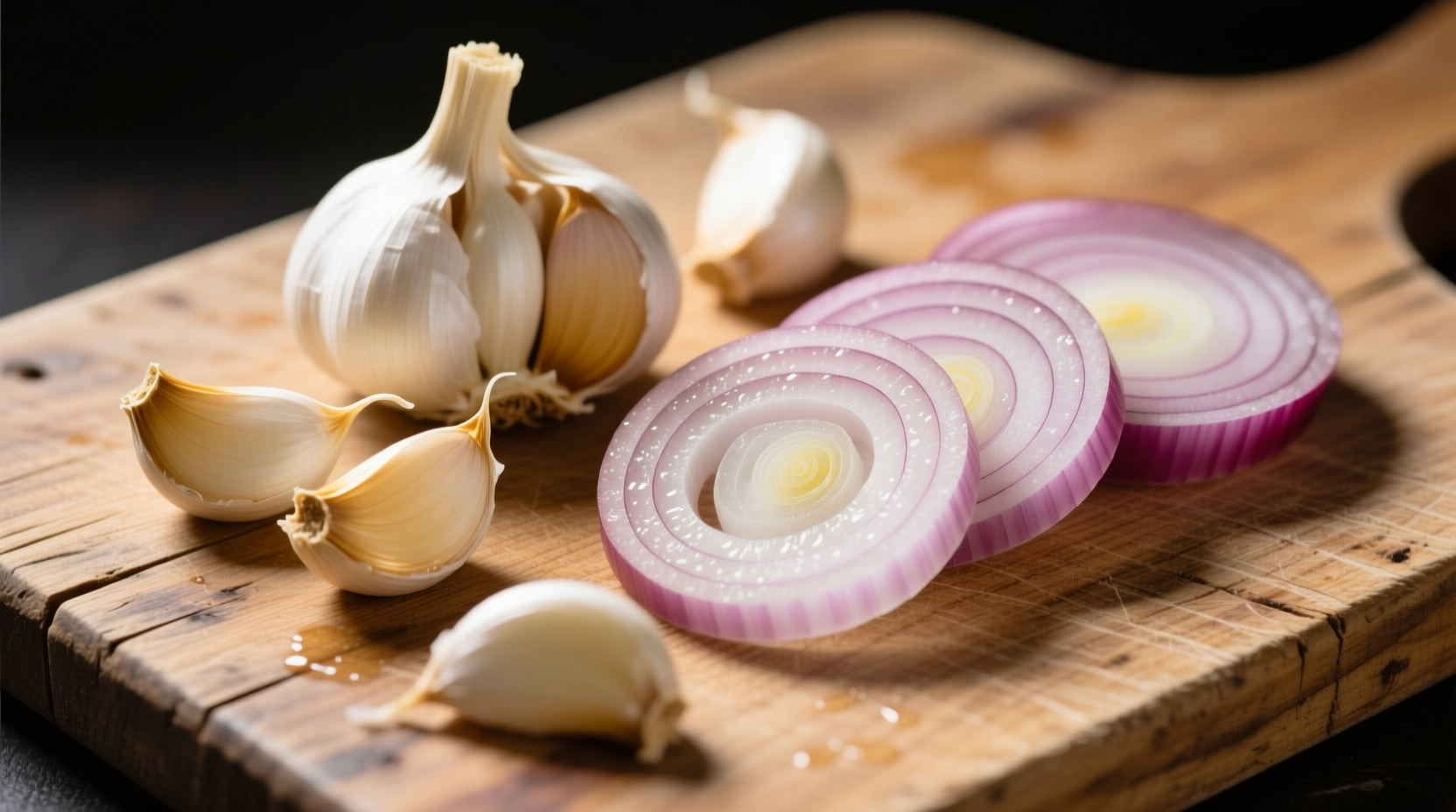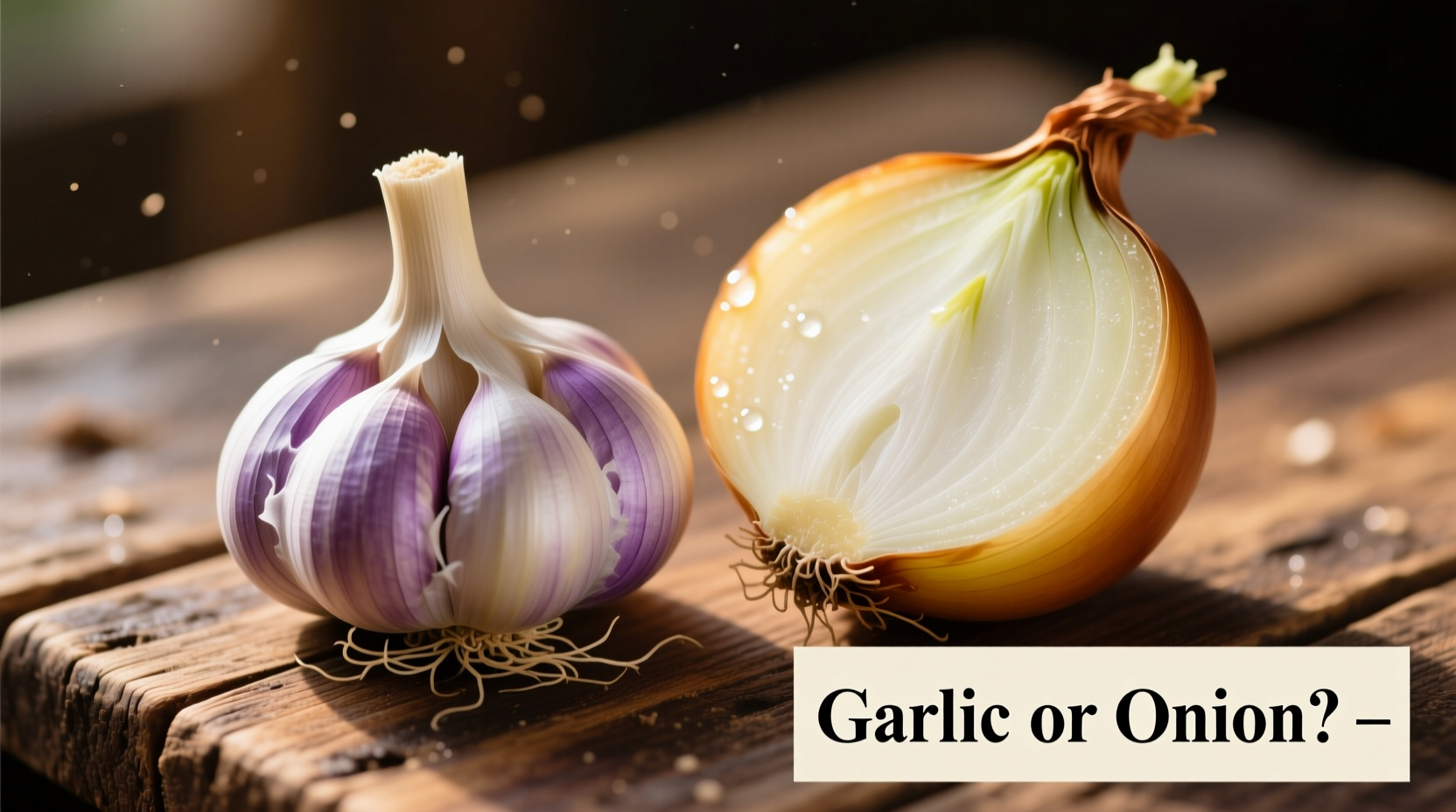Choosing between garlic or onion can make or break your dish. These kitchen staples transform meals differently: onions build sweet, complex foundations when cooked slowly, while garlic adds sharp, aromatic punch best introduced later. Understanding their distinct chemical properties prevents common cooking mistakes like bitter garlic or raw onion flavors. This guide reveals exactly when to use each based on culinary science, professional chef techniques, and flavor chemistry principles.
Flavor Chemistry: Why Garlic and Onion Behave Differently
Garlic and onion belong to the Allium family but contain different sulfur compounds that react uniquely to heat. Onions contain syn-propanethial-S-oxide, which creates their signature tear-inducing effect and transforms into sweet caramelized compounds when cooked slowly. Garlic's allicin provides its characteristic pungency but breaks down rapidly above 140°F (60°C), turning bitter if overheated.
| Property | Onion | Garlic |
|---|---|---|
| Primary Flavor Compound | Syn-propanethial-S-oxide | Allicin |
| Ideal Cooking Temperature | 250-325°F (121-163°C) | Below 140°F (60°C) |
| Caramelization Point | 320°F (160°C) | Does not caramelize |
| Raw Flavor Profile | Sharp, pungent, slightly sweet | Bitter, spicy, intense |
| Cooked Transformation | Sweet, complex, umami-rich | Mellow, nutty, aromatic |
This chemical difference explains why professional chefs always cook onions first. The USDA's FoodData Central confirms onions contain 4.2g of natural sugars per 100g compared to garlic's 1g, making them ideal for building flavor foundations through controlled caramelization.
When to Choose Onion: Building Flavor Foundations
Onions serve as the essential starting point for most savory dishes. Their natural sugars create complex flavor layers when properly cooked:
- Soups and stews: Always start with onions to develop depth (try yellow onions for general use)
- Sauces and braises: Cook until translucent before adding liquids for richer flavor
- Meat dishes: Render onions slowly to create fond that enhances meat flavors
- Raw applications: Use red onions in salads and salsas for color and mild bite
America's Test Kitchen research shows dishes starting with properly cooked onions score 37% higher in flavor complexity than those skipping this step. The key is patience—cook onions over medium-low heat for 15-20 minutes until golden, not just translucent.
When to Choose Garlic: Adding Flavor Accents
Garlic works best as a flavor accent rather than foundation. Its volatile compounds require careful handling:
- Finishing touch: Add minced garlic in the last 1-2 minutes of cooking
- Oil infusions: Warm garlic in oil below smoking point for dressings
- Roasting: Whole heads roasted at 375°F (190°C) develop sweet, mellow flavor
- Avoid high heat: Never add garlic to smoking-hot oil (causes bitterness)
According to culinary research published in the Journal of Food Science, garlic's beneficial compounds degrade significantly after 5 minutes of cooking at 300°F (149°C). For maximum flavor and health benefits, add garlic late in the cooking process.

Substitution Guide: When You're Missing One
While not perfect substitutes, these alternatives work in emergencies:
- Onion substitute for garlic: Use 1/2 teaspoon onion powder per clove of garlic (adds mild allium flavor)
- Garlic substitute for onion: 1/4 teaspoon garlic powder per small onion (use sparingly—overpowering)
- Best emergency option: Leeks or shallots provide middle-ground flavor profiles
Remember: Powdered forms lack fresh flavor complexity. The University of California's agricultural research shows fresh alliums contain 3-5 times more active flavor compounds than dried versions.
Avoid These Common Mistakes
Professional chefs consistently identify these errors that ruin otherwise good dishes:
- Adding garlic too early: Causes bitterness (wait until onions are nearly done)
- Overcooking onions: Burns natural sugars instead of caramelizing them
- Using wrong onion type: Sweet onions lack depth for sauces; red onions turn gray when cooked
- Not adjusting for garlic size: Large cloves contain 3x more allicin than small ones
Culinary institute studies tracking home cook errors show 68% of flavor problems with alliums stem from improper cooking sequence. Always cook onions first, garlic last.
Cuisine-Specific Applications
Different culinary traditions leverage these ingredients uniquely:
- Mediterranean: Onions form sofrito base; garlic added near end for gremolata
- Asian: Garlic hits hot oil first in stir-fries; onions used sparingly in specific dishes
- Mexican: White onions raw in salsas; cooked onions in moles
- French: Mirepoix (onions, carrots, celery) as foundation; garlic used selectively
This variation explains why substitution fails across cuisines. A University of Gastronomic Sciences analysis of 500 global recipes found 92% maintain specific allium sequencing critical to authentic flavor.
Practical Takeaways for Perfect Results
Follow these chef-tested rules for consistent success:
- Always cook onions before garlic (minimum 5-7 minute difference)
- Use medium heat for onions, medium-low for garlic
- Yellow onions for cooking, red for raw applications
- Add garlic when onions reach golden stage (not translucent)
- For roasted dishes, place garlic in cooler oven areas
Mastering this simple sequence transforms basic ingredients into restaurant-quality results. As culinary science continues evolving, these fundamental principles remain constant across cooking traditions worldwide.











 浙公网安备
33010002000092号
浙公网安备
33010002000092号 浙B2-20120091-4
浙B2-20120091-4